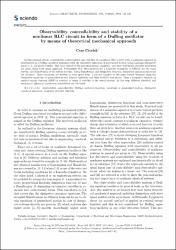Observability, controllability and stability of a nonlinear RLC circuit in form of a Duffing oscillator by means of theoretical mechanical approach
Citation
In this research article, observability, controllability and stability of a nonlinear RLC circuit with a nonlinear capacitor is investigated as a Duffing oscillator beginning with the dissipative equations of generalized motion using Lagrange-dissipative model ({L, D}-model briefly). The force related to the potential energy, equilibria, and their well known stability properties are given using state space approach. Prerequisite that the condition for a Legendre transform is fulfilled, for the same system, also Hamiltonian of the system is found. Using Hamiltonian and dissipation function, dissipative canonical equations are obtained. These equations are written in state space form. Then the equality to the same results obtained using the dissipative equations of generalized motion related equilibria and their stability was shown. Thus a Lyapunov function as residual energy function (REF) is justified in terms of stability of the overall system. As last step, different electrical and mechanical (physical) realization possibilities are discussed.Abstract
In this research article, observability, controllability and stability of a nonlinear RLC circuit with a nonlinear capacitor is investigated as a Duffing oscillator beginning with the dissipative equations of generalized motion using Lagrange-dissipative model ({L, D}-model briefly). The force related to the potential energy, equilibria, and their well known stability properties are given using state space approach. Prerequisite that the condition for a Legendre transform is fulfilled, for the same system, also Hamiltonian of the system is found. Using Hamiltonian and dissipation function, dissipative canonical equations are obtained. These equations are written in state space form. Then the equality to the same results obtained using the dissipative equations of generalized motion related equilibria and their stability was shown. Thus a Lyapunov function as residual energy function (REF) is justified in terms of stability of the overall system. As last step, different electrical and mechanical (physical) realization possibilities are discussed.

















